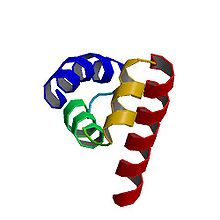- UBR5
-
E3 ubiquitina-proteína ligasa UBR5 
Estructura tridimensional de la proteína UBR5.HUGO 16806 Símbolo UBR5 Símbolos alt. EDD1, DD5, EDD, FLJ11310, HYD, KIAA0896, MGC57263 Datos genéticos Locus Cr. 8 q22 Bases de datos Entrez 51366 OMIM 608413 PDB 1i2t RefSeq NP_056986 UniProt P28482 La E3 ubiquitina-proteína ligasa UBR5 es una enzima codificada en humanos por el gen ubr5.[1] [2] [3]
UBR5 es una proteína inducida por progestina, que pertenece a la familia HECT (de sus siglas en inglés "homology to E6-AP carboxyl terminus"). Las proteínas de la familia HECT actúan como E3 ubiquitina-proteínas ligasas, marcando proteínas específicamente para proteolisis mediada por ubiquitina. Este gen se localiza en el cromosoma 8, locus q22, y se ha encontrado mutado o eliminado en diversos tipos de cáncer. Este gen tiene un papel potencial en la regulación de la proliferación celular y de la diferenciación celular.[3]
Interacciones
La proteína UBR5 ha demostrado ser capaz de interaccionar con:
Referencias
- ↑ Callaghan MJ, Russell AJ, Woollatt E, Sutherland GR, Sutherland RL, Watts CK (Mar 1999). «Identification of a human HECT family protein with homology to the Drosophila tumor suppressor gene hyperplastic discs». Oncogene 17 (26): pp. 3479–91. doi:. PMID 10030672.
- ↑ Tasaki T, Mulder LC, Iwamatsu A, Lee MJ, Davydov IV, Varshavsky A, Muesing M, Kwon YT (Aug 2005). «A family of mammalian E3 ubiquitin ligases that contain the UBR box motif and recognize N-degrons». Mol Cell Biol 25 (16): pp. 7120–36. doi:. PMID 16055722.
- ↑ a b «Entrez Gene: EDD1 E3 ubiquitin protein ligase, HECT domain containing, 1».
- ↑ Honda, Yoshiomi; Tojo Masahide, Matsuzaki Kazuhito, Anan Tadashi, Matsumoto Mitsuhiro, Ando Masayuki, Saya Hideyuki, Nakao Mitsuyoshi (Feb. 2002). «Cooperation of HECT-domain ubiquitin ligase hHYD and DNA topoisomerase II-binding protein for DNA damage response». J. Biol. Chem. (United States) 277 (5): pp. 3599–605. doi:. ISSN 0021-9258. PMID 11714696.
- ↑ a b Henderson, Michelle J; Russell Amanda J, Hird Samantha, Muñoz Marcia, Clancy Jennifer L, Lehrbach Gillian M, Calanni Sophina T, Jans David A, Sutherland Robert L, Watts Colin K W (Jul. 2002). «EDD, the human hyperplastic discs protein, has a role in progesterone receptor coactivation and potential involvement in DNA damage response». J. Biol. Chem. (United States) 277 (29): pp. 26468–78. doi:. ISSN 0021-9258. PMID 12011095.
- ↑ Eblen, Scott T; Kumar N Vinay, Shah Kavita, Henderson Michelle J, Watts Colin K W, Shokat Kevan M, Weber Michael J (Apr. 2003). «Identification of novel ERK2 substrates through use of an engineered kinase and ATP analogs». J. Biol. Chem. (United States) 278 (17): pp. 14926–35. doi:. ISSN 0021-9258. PMID 12594221.
Wikimedia foundation. 2010.
